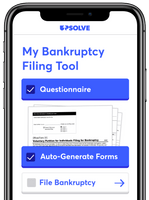Understanding the CAIVRS Federal Database
4 minute read • Upsolve is a nonprofit that helps you get out of debt with education and free debt relief tools, like our bankruptcy filing tool. Think TurboTax for bankruptcy. Get free education, customer support, and community. Featured in Forbes 4x and funded by institutions like Harvard University so we'll never ask you for a credit card. Explore our free tool
If you’ve been delinquent in repaying or defaulted on a federal debt, that information is stored in a database known as CAIVRS. This allows federal agencies to share information about your credit history, and lenders use it to determine your creditworthiness. Six federal agencies report information to the database. If you’ve defaulted with any of these six agencies and they report it, you’ll likely be denied if you apply for another government-backed loan. Not all federal loan defaults are in the database. Sometimes the information in the database isn’t accurate, but you should be able to clean it up.
Written by Attorney William A. McCarthy.
Updated November 17, 2021
Table of Contents
Defaulting on federal debts can prevent you from qualifying for additional federal loans down the road. Federal agencies share information about your credit history, and lenders use it to determine your creditworthiness. Federal loan delinquency and default information is stored in a database known as CAIVRS. If you’ve neglected your payments to an agency that feeds information into the database, you’ll likely fail the screening and be denied the loan. But not all federal loan defaults are in the database, and sometimes the information in the database isn’t accurate.
This article will help you understand how the CAIVRS database works, which lenders use it, and what you can do to clean up your report and qualify for a government-backed loan.
What Is CAIVRS?
CAIVRS (pronounced kay-vers) is a federal database lenders use when you apply for a federal loan or guaranteed federal loan. As part of the loan application process, lenders check the database to see if you’ve defaulted or are delinquent on any federal loans. If so, you’ll be considered a credit risk, and the lender will likely deny your loan application.
CAIVRS was developed in 1987 by the U.S. Department of Housing and Urban Development (HUD) as a database of defaulted federal borrowers. Now many private lenders and federal agencies use it to ensure that borrowers who are backed by the federal government are creditworthy. CAIVRS is one database with two different names. It began as the Credit Alert Interactive Voice Response System. However, because it went from a phone (voice) service to an online service, it’s now often referred to as the Credit Alert Verification Reporting System.
Information in the Database
The CAIVRS database includes information on individuals who’ve defaulted on government debt, who’ve had obligations paid (by the government) on guaranteed federal debt, or who are delinquent on certain federal debts. This includes foreclosures on FHA home loans, defaulted student loans, federal liens, and certain unpaid federal court judgments.
Six federal agencies feed information into the database:
Department of Housing and Urban Development (HUD)
Department of Veterans Affairs (VA)
Small Business Administration (SBA)
Department of Education (ED)
Department of Agriculture (USDA)
Department of Justice (DOJ)
If you’ve defaulted on an obligation to one of these organizations, it will likely be in the database. But a CAIVRS check won’t detect all types of delinquent government debt. For example, IRS tax deficiencies aren’t typically reported to CAIVRS. But lending agencies have other ways to check your eligibility for a loan or creditworthiness. They also look at your credit reports (and credit score), which may reflect tax deficiencies, and your loan applications to identify other debt obligations you may be delinquent in paying or have defaulted on.
How Long Information Remains in the Database
Information regarding defaulted or delinquent debt remains in the database for three years after the foreclosure or after the debt is paid by the government. Ongoing delinquent obligations, such as federal student loans, remain in the database until they are paid.
How the Database Works
The FHA, VA, and USDA insure mortgage loans for qualified buyers by guaranteeing the lending agency will get paid if the borrower defaults and doesn’t pay back the loan. Some agencies, like the USDA, also offer direct loans to borrowers. When you apply for an FHA, VA, or USDA guaranteed loan, the lender will enter your Social Security number (SSN) into CAIVRS. The database will either generate a clean report or show you’ve been delinquent on or defaulted on federal debt in the past.
For example, assume you defaulted on a VA loan two years ago and the VA had to step in and limit the bank’s loss by paying off the debt. If you now apply for an FHA mortgage, the bank will run your SSN through the CAIVRS database. The VA loan default will show up on the report and you will be denied the FHA loan. At that point, you could consider a conventional loan which may not involve a CAIVRS screening. But the loan default might affect your credit score if it’s reported to a credit bureau.
Upsolve Member Experiences
2,029+ Members OnlineCan You Check Your Own CAIVRS Report?
You can't request a copy of or check your own CAIVRS report. You’ll have to wait until a lending agency requests a report in connection with a government-backed loan application. If there’s something on the report, they will notify you, and you can request the details.
What a Report Will Show
If you’re screened and the database has information about a delinquent federal debt, the CAIVRS report will show:
The name of the agency that reported the delinquency
The type of delinquent debt
Contact information for the reporting agency
You can contact the reporting agency for more information. It’s a good idea to learn all you can about what’s on the report because it may not be accurate, and you may be able to clear it up.
Fixing a Report
If your CAIVRS report shows a federal loan default, you may be able to do something about it. Don’t assume it’s accurate and permanent, especially if it doesn’t sound right. By cleaning up the report, you might still be able to get the loan.
Review the information for accuracy. We all know that federal agencies make mistakes. If you uncover a mistake, notify the reporting agency, and have documentation supporting your position handy. The reporting agency should correct the error and update the database.
There are other reasons the database may have inaccurate information. You could have been the victim of identity theft, for example, and the perpetrator may have defaulted on a federal loan in your name. Things like that happen.
Even if you’re notified of actual delinquencies, you may be able to clear those up, too. If it’s a VA loan, for example, you could get back on track with a repayment plan or possibly refinance using a conventional loan. If it’s a student loan, you could pay it off. The three-year clock will start ticking on the VA loan, but the student debt should drop off the database after it’s paid in full. Also, you may be able to get an FHA-insured mortgage even with a blemish on your report if you can prove your past failure to pay wasn’t your fault.
Let's Summarize...
Borrowers applying for loans backed by the FHA, VA, or USDA will be screened through a federal database that contains information regarding federal loan defaults. The CAIVRS database, created by HUD, gathers delinquency information from six different government agencies: HUD, VA, SBA, ED, USDA, and DOJ.
Information regarding defaulted debt remains in the database for three years and ongoing delinquencies like student loans remain in the database until the loan is paid. The participating agencies, as well as many private lenders, have access to the information and use it when you apply for a government loan or guaranteed loan. If you’re screened and a default or delinquency shows up, you’ll likely be denied the loan.
You can’t request a copy of your CAIVRS report, but a lender will notify you if there’s a problem. If there is, don’t lose hope. It may be an error or something you can fix. Cleaning up the report may allow you to get that loan after all.












